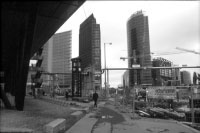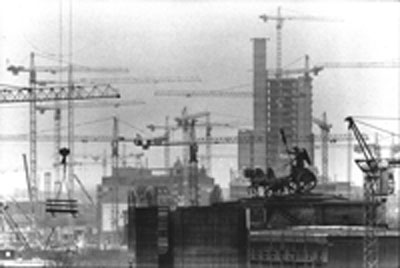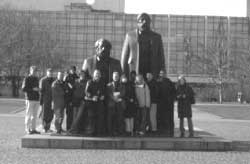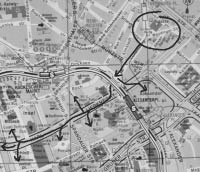During the Winter 2000 semester, Karein Goertz (Residential College) and Mick Kennedy (College of Architecture) team-taught a new course entitled "Explorations in Berlin: Zu Fuß im Kiez." Organized as a series of walking tours through Berlin's neighborhoods or Kiez, the seminar introduced students to the city through the various lenses of cartography, literature, architecture, film, photography, and music. Readings included works by important literary and cultural figures such as Rahel Varnhagen, Walter Benjamin, Alfred Döblin, Christopher Isherwood, and Peter Schneider. Building projects by architects Karl Schinkel, Felix Mendelsohn, Hans Scharoun and Norman Foster were viewed within the larger social and cultural context of the city. After spending six weeks in class creating a mental map of Berlin, the class was prepared to test its virtual knowledge of the city against actual experience. The ten-day trip during Spring Break provided an exciting opportunity for students to walk through and explore Berlin's diverse neighborhoods&emdash;Mitte, Kreuzberg, Prenz-lauerberg, Charlottenburg, Tiergarten. For most students, this was the first visit to the German capital; for some even the very first time
|
in the former East Berlin
Part of the first day's |
overseas. At the end of the trip, however, everyone was intimately familiar with the subway system, had discovered their favorite bakeries and Döner kebap stands, and had picked up some useful German expressions. Those with German language skills were at a particular advantage since they were quickly able to converse with Berliners and could act as language guides for the rest of the students. While many of the cultural activities were done as a class, there was plenty of time to pursue research for the final class project and to discover the city at an individual pace. One of the goals of the trip was for student teams to assemble audio, visual, textual, and anecdotal material for a multi-media walking tour based on their own physical exploration of a particular neighborhood, area or public space. |
Throughout
the week, the group was able to take advantage of
Berlin's vast cultural offerings. This diversity
and density of experiences sought to mimic the
breadth of materials presented in class, stressing
the interconnection between architectural space and
performance, literary and cultural history. Thus,
for example, we a piano concert by Beethoven in the
Expressionist splendor of Sharoun's Philharmonic;
attended a Dada play by Kurt Schwitter's about the
origin of language in the Berliner Ensemble;
watched a modern dance performance about Germany's
split identity in Mendelsohn's Schaubühne; and
learned how the architect Daniel Libeskind's
training in music and interest in German literature
filtered into his design of the Jewish Museum. We
were given a group tour of the building by Carla
Swickerath from the Libeskind office and later
visited the architect's studio filled with models
and drawings of past and ongoing projects.
Throughout the eastern part of the city, we
observed how old buildings, inner courtyards and
public arcades are being renovated and reused in
creative and dynamic ways. On one of the stages of
the Kulturbrauerei multiplex, formerly a brewery,
we saw a cabaret-style tribute to the composer Kurt
Weill. In the Tresor night club, housed in the
money vault of an old department store, students
danced to techno music. In another
turn-of-the-century department store, Tacheles,
which has been left as a ruin and now serves as a
cultural center, we visited artist studios. As some
of the novelty of these places wears off, the
Berliner counter-culture continues to seek out
other places. They look appalled at the Potsdamer
Platz, Metropolitan rabbits hop to their delight
on Looking at this meadow How can I believe what my grandfather
recounted Here was the very center of the world They're churning up the ground for the
capital city. Earth removers go in in advance of the
nocturnal desolation. Germania in her bunker, stretched out on her
Prussian chaise longue, Is disturbed in her sleep, and rolls over in
the dirt. --Durs Grünbein (1990s)) This
eventful week had its highlights. Most unique was
certainly the experience of putting on hardhats and
walking onto the construction site and roof of the
Federal Chancellery building with the architect,
Axel Schultes. Once this federal building is
completed, only security men and the occasional
mechanic will be able to savor that particular view
over the city. Schultes and his partner, Charlotte
Frank, joined the group for lunch to discuss their
project and the Berlin redevelopment, which was
clearly and spectacularly visible from the new
glass cupola of the adjacent Reichstag. Most
sobering was the tour of the Sachsenhausen
concentration camp outside of Berlin during an
unexpected snow storm. In class, we had discussed
the book burnings at Bebel Platz and anti-semitic
propaganda. Here we saw, in a very tangible way,
the consequences of these acts. The close proximity
of concentration camp, new government buildings,
art museums, concert halls, glittering
redevelopment of Potsdamer Platz, former Gestapo
and Stasi headquarters, synagogues and mosques,
wartime ruins, remnants of the Berlin wall, and
expansive greenspaces make this rapidly changing
city a complex, unique and intriguing place to
visit and study. --Karein
K. Goertz
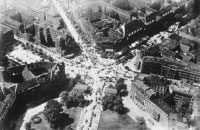
And complain about the din.
The night's a blaze of kilowatts . . .
It sounds as if the city groans
To hear a muttered curse.
The buildings twinkle, the UBahn moans.--
--Erich Kästner (1920s)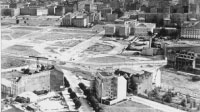
Potsdamer Platz--Sarah Kirsch (1980s)
